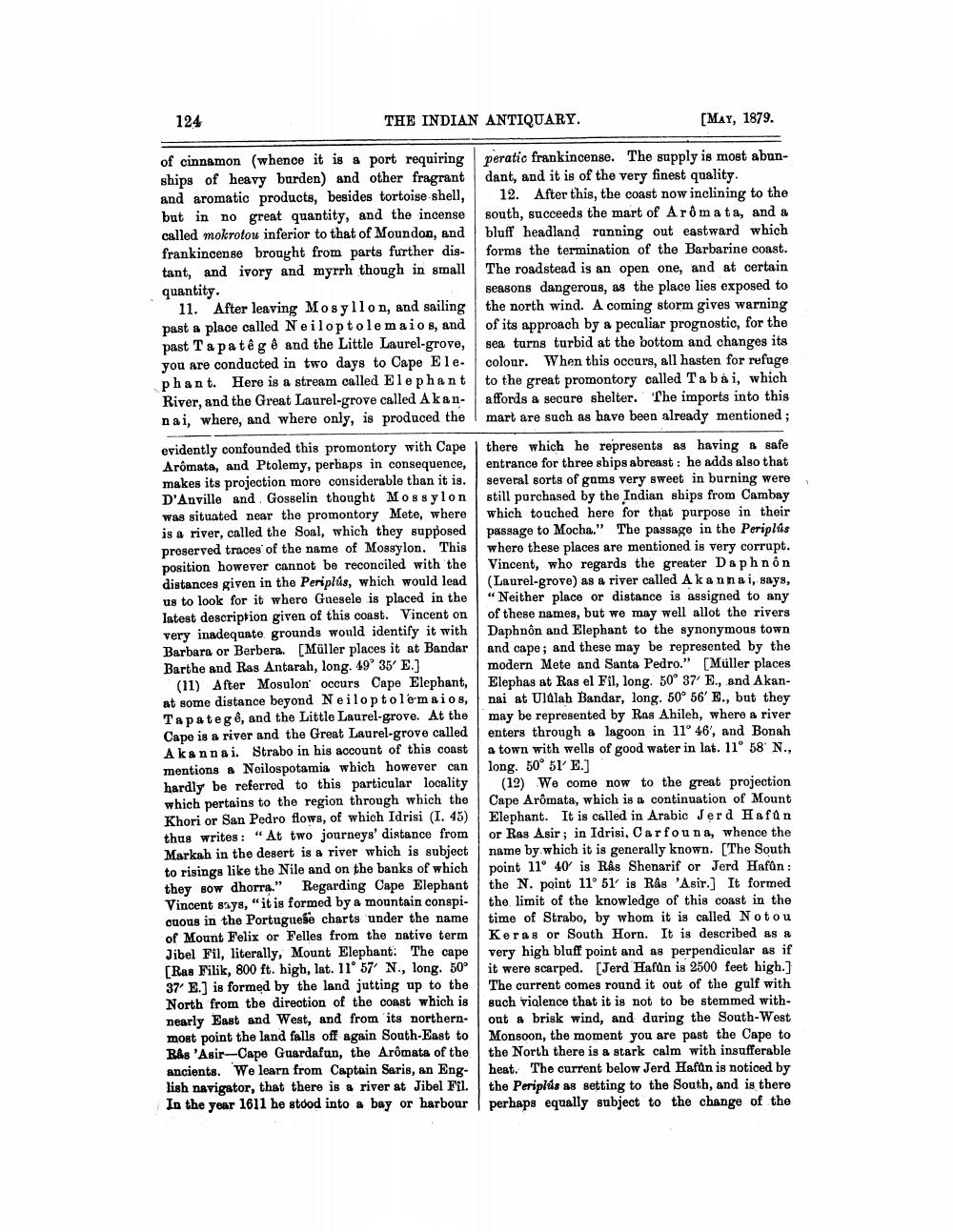________________
124
THE INDIAN ANTIQUARY.
[MAY, 1879.
=
of cinnamon (whence it is a port requiring peratic frankincense. The supply is most abunships of heavy burden) and other fragrant dant, and it is of the very finest quality. and aromatic products, besides tortoise shell, 12. After this, the coast now inclining to the but in no great quantity, and the incense south, succeeds the mart of Arômata, and a called mokrotou inferior to that of Moundon, and bluff headland running out eastward which frankincense brought from parts further dis- forms the termination of the Barbarine coast. tant, and ivory and myrrh though in small The roadstead is an open one, and at certain quantity.
seasons dangerous, as the place lies exposed to 11. After leaving Mosyllon, and sailing the north wind. A coming storm gives warning past a place called Neiloptolemaios, and of its approach by a peculiar prognostic, for the past Ta patêgê and the Little Laurel-grove, sea turns turbid at the bottom and changes its you are conducted in two days to Cape Ele. colour. When this occurs, all hasten for refuge phant. Here is a stream called Elephant to the great promontory called Tabái, which River, and the Great Laurel-grove called Akan- affords a secure shelter. The imports into this nai, where, and where only, is produced the mart are such as have been already mentioned ; evidently confounded this promontory with Cape there which he represents as having a safe Aromata, and Ptolemy, perhaps in consequence, entrance for three ships abreast : he adds also that makes its projection more considerable than it is. several sorts of gams very sweet in burning were D'Anville and Gosselin thought Mossylon still purchased by the Indian ships from Cambay was situated near the promontory Mete, where which touched here for that purpose in their is a river, called the Soal, which they supposed passage to Mocha." The passage in the Periplus proserved traces of the name of Mossylon. This where these places are mentioned is very corrupt. position however cannot be reconciled with the Vincent, who regards the greater Daphnôn distances given in the Periplus, which would lead (Laurel-grove) as a river called Akannai, says, us to look for it where Guesele is placed in the "Neither place or distance is assigned to any latest description given of this coast. Vincent on of these names, but we may well allot the rivers very inadequate grounds would identify it with Daphnôn and Elephant to the synonymous town Barbara or Berbera. [Müller places it at Bandar and cape; and these may be represented by the Barthe and Ras Antarah, long. 49° 35' E.] modern Mete and Santa Pedro." [Müller places
(11) After Mosulon occurs Cape Elephant, Elephas at Ras el Fil, long. 50° 37' E., and Akanat some distance beyond Neiloptolemaios, nai at Uldlah Bandar, long. 50° 56' E., but they Tapategê, and the Little Laurel-grove. At the may be represented by Ras Ahileh, where a river Cape is a river and the Great Laurel-grove called enters through a lagoon in 11° 46', and Bonah
A ka nnai. Strabo in his account of this coast a town with wells of good water in lat. 11° 58' N., mentions & Neilospotamia which however can long. 50° 51' E.] hardly be referred to this particular locality (12) We come now to the great projection which pertains to the region through which the Cape Aromata, which is a continuation of Mount Khori or San Pedro flows, of which Idrisi (I. 45) Elephant. It is called in Arabic Jerd Hafan thus writes: "At two journeys' distance from or Ras Asir; in Idrisi, Carfou na, whence the Markah in the desert is a river which is subject name by which it is generally known. [The South to risings like the Nile and on the banks of which point 11° 40 is Râs Shenarif or Jerd Hafûn : they bow dhorra." Regarding Cape Elephant the N. point 11° 51' is Râs 'Asir.] It formed Vincent says, "it is formed by a mountain conspi- the limit of the knowledge of this coast in the cuous in the Portuguese charts under the name time of Strabo, by whom it is called Notou of Mount Felix or Felles from the native term Keras or South Horn. It is described as a Jibel Fil, literally, Mount Elephant: The cape very high bluff point and as perpendicular as if Ras Filik, 800 ft. high, lat. 11' 57' N., long. 50o it were scarped. (Jerd Hafan is 2500 feet high.] 37' E.] is formed by the land jutting up to the The current comes round it out of the gulf with North from the direction of the coast which is such violence that it is not to be stemmed withnearly East and West, and from its northern- out a brisk wind, and during the South-West most point the land falls off again South-East to Monsoon, the moment you are past the Cape to RAs 'Asir-Cape Guardafun, the Aromata of the the North there is a stark calm with insufferable ancients. We learn from Captain Saris, an Eng- heat. The current below Jerd Hafan is noticed by lish navigator, that there is a river at Jibel Fil. the Periplus as setting to the South, and is there In the year 1611 he stood into a bay or harbour perhaps equally subject to the change of the




